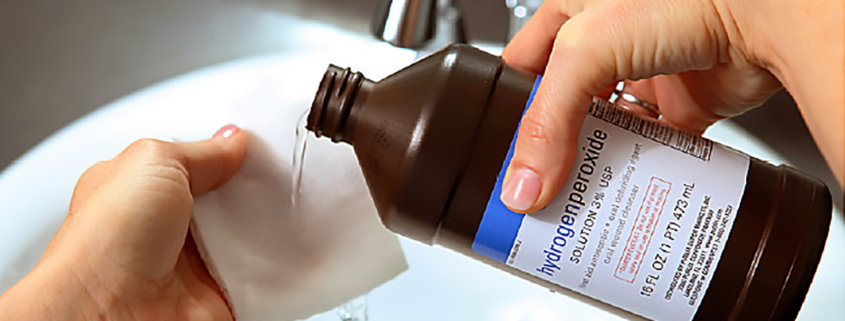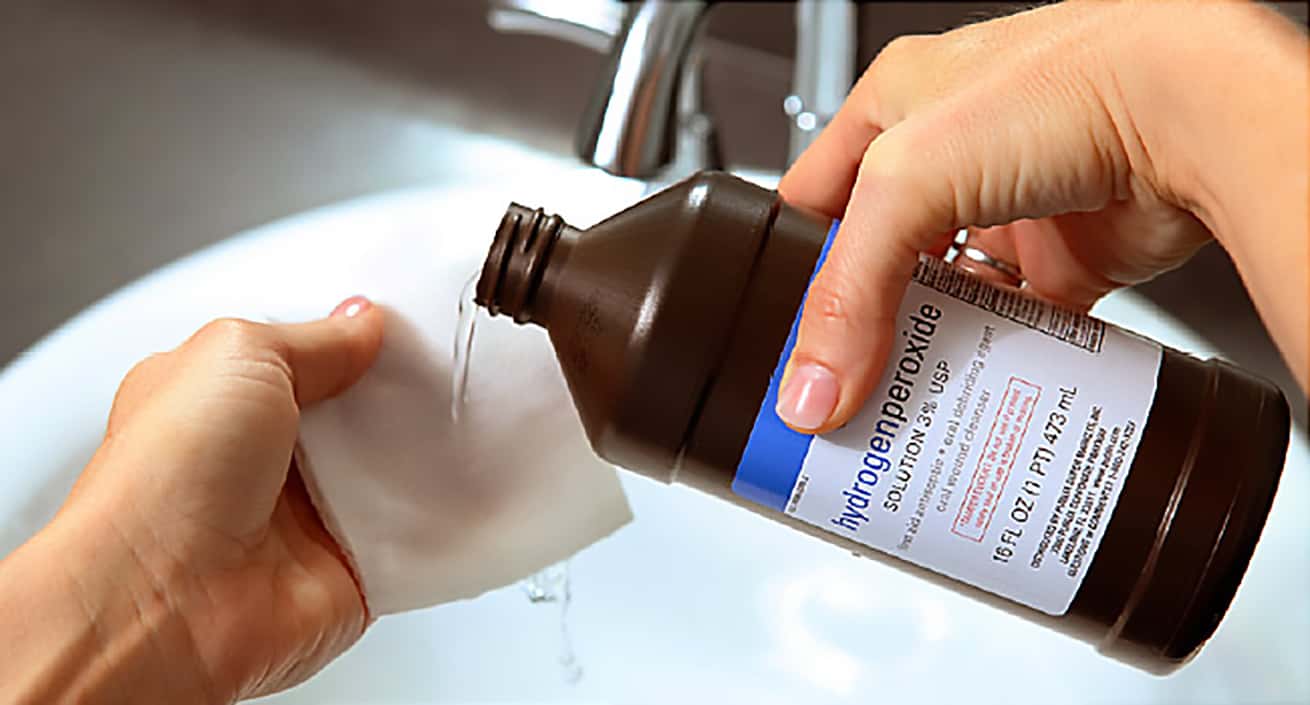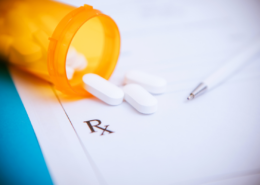31 Remarkable Ways to Use Hydrogen Peroxide to Improve Your Life
Hydrogen peroxide—it’s inexpensive and readily available. And why would anyone want to keep this non-toxic, odorless product around the house? Because of myriad hydrogen peroxide cleaning uses.
Hydrogen peroxide is as harmless as it is powerful both as a household cleaner and as an all-around remedy. It is non-toxic, safe, really cheap, safe in a septic system, and available in any grocery or drug store in a 3% dilution.
Hydrogen peroxide is an excellent cleaning product, first aid, and reliable sanitizer. It is also a powerful oxidizer, making it useful for whitening and bleaching.
It Must Be Fresh
One thing you need to keep in mind to avoid disappointment: Hydrogen peroxide has a limited shelf life of about one year when not opened and only six months once opened, provided you store it in a dark place.
Heat, light, and air cause hydrogen peroxide to dissipate. quickly turning it from H2O2 to plain water and oxygen. It loses its “fizz,” energy, and power. It needs to be fresh to be effective.
If it’s been opened and older than six months, throw it out. It is not harmful, but it becomes useless! You will be terribly disappointed.
To ensure that you never have to throw out hydrogen peroxide again, check out how you can use it around the house to make your life easier.
1. Sanitize the refrigerator
Use 3% hydrogen peroxide undiluted in a spray bottle to clean and sanitize the walls and shelves of your refrigerator. Because it is non-toxic, it is absolutely safe to use around food.
2. Vegetable wash
You can stop paying $7 or more for “veggie wash.” Make your own by adding 1/4 cup 3% hydrogen peroxide to a sink of cold water. Wash your fruit and vegetables in the solution then rinse thoroughly with cool water.
3. Disinfect, freshen kitchen sponges
Kitchen sponges and dishcloths can harbor bacteria, including E.coli and Salmonella. Disinfect them daily in a solution of 50 percent water and 50 percent hydrogen peroxide. So easy!
4. Clean your dishwasher
A 2016 study of dishwashers found that 83% of the residential dishwashers they tested were positive for fungi, and 47 percent of dishwashers tested contained the black yeast E. dermatitidis, which can be harmful to humans. E. dermatitidis was detected primarily at the dishwasher rubber seals.
To disinfect your dishwasher, add 1/4 cup 3% hydrogen peroxide before you close the door to run an empty complete cycle. Or if you feel like giving this hardworking appliance a spa day, one option is to use hydrogen peroxide, baking soda, and essential oils to make a scented dishwasher “bomb.”
5. Sanitize a load of dishes
An effective way to help sanitize dishes is to add about 2 oz. (1/8 cup) fresh hydrogen peroxide to the loaded-up dishwasher along with your regular detergent. Just pour it right in.
6. Breath freshener
Bad breath is a clear sign of halitosis, caused by bacteria. An easy, effective way to kill that bacteria is with this simple homemade mouthwash: Mix hydrogen peroxide and water equal parts. Swish this in your mouth for one minute, then spit it out. Make it fresh for each use.
7. Keep houseplants healthy
To keep houseplants free of disease and fungus, add a tablespoon of hydrogen peroxide to a spray bottle filled with water to mist and spritz your plants.
8. Disinfect shopping bags
More than likely, the reusable bags you take to the supermarket are contaminated with germs, even E-coli. That’s because grocery bags often come in contact with poultry meats and produce that have bacteria on them which causes cross-contamination the next time they are used.
These bags should be laundered after every use, but most shoppers admit they’ve never done that. A more straightforward solution is to spray them inside and out with 3% hydrogen peroxide.
9. Remove blood stains
Blood stains on kitchen towels, clothes, or other items can be difficult to remove. The secret is to saturate the stain with hydrogen peroxide. Allow to sit for a few minutes, rinse with water, and then launder as usual.
Some time ago I got a message, which reminded me about this particular wonder of hydrogen peroxide Georgia wrote …
I had a cut on my hand that opened up while I was putting my expensive duvet cover on my comforter. Now I have blood stains where I touched it. Is there any hope of getting these stains out completely? I tried using a carpet cleaning solution and washing it but those stains remain. I’m worried they’ll be there permanently. Thanks so much for your help!
I responded immediately, directing Georgia to soak the stains with fresh, full-strength hydrogen peroxide. I heard back quickly. The hydrogen peroxide lightened the stains almost immediately, and within hours disappeared completely.
10. Pretreat stains
Pretreat stains on clothing and linens with fresh hydrogen peroxide. Spray it on, then let it sit on the stain for a little while before tossing the item into the washer.
11. Whiten laundry
Add one cup of hydrogen peroxide to a load of white laundry to whiten and brighten without using chlorine bleach. Allow to pre-soak for 15 minutes, if possible, before you start the wash cycle.
12. Discolored nails, too
For fingernails or toenails that have become yellowed and otherwise discolored, mix on part hydrogen peroxide to two parts baking soda in a small bowl, to make a paste. It’s going to foam up a bit but when it stops, spread the paste over and under fingernails and toenails. Allow it to work for 3 to 5 minutes, then rinse away with clear water.
13. Sanitize manicure and beauty tools
Everything from eyelash curlers, tweezers, and makeup brushes to pedicure tools, files, and nippers—come in direct contact with bacteria from your skin and body soil. All it takes is a dip in a small pool of fresh hydrogen peroxide to remove those impurities and leave them fresh and sanitized. It’s simple to do, but it’s a task most of us just don’t think about.
14. Sweeten smelly feet
If you or someone you know and love is plagued by stinky, smelly feet—the problem is odor-causing bacteria. The solution is a foot soak with one part hydrogen peroxide to three parts warm water. As a bonus, this same treatment will soften calluses and corns and help protect against spreading Athlete’s Foot fungus.
15. Scour cookware, bakeware
If your cookie sheets, pots, and pans have a baked-on layer of brown gunk (and you’ve decided to stop calling it a lovely patina), sprinkle them with baking soda, then spritz the soda with 3% hydrogen peroxide. Allow soaking for 1 to 3 hours before wiping off the mess. A really challenging situation may require a little elbow grease and a scrubber sponge to remove the gunk.
16. Cutting board sanitizer
According to The Ohio State University Extension, cleaning counters with undiluted hydrogen peroxide effectively kills E. coli and Salmonella bacteria on hard surfaces like counters when allowed to sit on the surface for 10 minutes at room temperature.
Spray your cutting board with undiluted, fresh hydrogen peroxide. Allow to sit for at least 10 minutes, then rinse clean.
17. Baked-on mess
Here’s a simple way to remove the cooked-on mess left behind in a casserole dish, pot or pan: Mix up a paste of equal parts hydrogen peroxide and baking soda. Paint it on the mess using your fingers, sponge or your favorite pastry brush. Allow to sit for a while. Later, give that mess a good scrub and watch the mess come right off.
18. Disinfect countertops
Mix hydrogen peroxide with water in equal parts in a spray bottle. Apply directly to the surfaces in the kitchen and bathroom—any place you want to keep sanitized. Wipe dry with a clean towel or sponge
19. T-shirt armpit stains
Those yellow stains in white t-shirts are quite annoying. To get them out, follow the step-by-step instructions here: How to Remove Yellow Sweat Stains—It Really Works!
20. Sanitize toys and lunch boxes
Because hydrogen peroxide is a non-toxic, safe and effective sanitizer, it’s perfect for cleaning plastic toys and lunch boxes.
21. Humidifier cleanse
Add 2 cups 3% hydrogen peroxide to one gallon of water. Run this through your humidifier or steamer to clean and sanitize the appliance.
23. Stinky towels
Can’t get rid of that annoying odor? Try this: Add 1/2 cup fresh hydrogen peroxide and 1/2 cup white vinegar to the washing machine along with those stinky towels. If you have a front loader, once you’ve added the towels to the machine, pour the hydrogen peroxide and white vinegar on the towels, before you close the door. Now go ahead and add your regular detergent, fill with hot water and hit “Pause” or otherwise stop the machine and allow it to soak for 15 minutes. Continue the cycle as normal. That should get rid of the smell. If you still detect that odor read this solution for gross, smelly towels for more aggressive treatment.
24. Aquarium maintenance
Use hydrogen peroxide sparingly to control fungi and other pests in fish aquariums. Provided you use it sparingly, it will not harm the fish. For specific instructions, read more here.
25. Homemade toothpaste
To whiten teeth with hydrogen peroxide: Mix baking soda and hydrogen peroxide to make a paste for brushing your teeth. Not only will this help to reverse the early stages of gingivitis, used regularly, but it will also remove stains and whiten your teeth. Adding a little ordinary table salt to the mixture will boost your toothpaste’s teeth whitening effects.
Because hydrogen peroxide dissipates quickly, you’ll need to make this right before every use.
26. Disinfect toothbrushes and mouth guards
At least weekly, pouring some hydrogen peroxide over your toothbrushes is a great idea. This can help kill staph and other bacteria, lessening the chance of introducing it back into your mouth.
27. Kill mold and mildew
You may have noticed—especially during the hot, humid summer months—that mold and mildew can build up quickly in a shower stall.
To kill mold and mildew, spray with undiluted 3% hydrogen peroxide and allow it to sit for 30 minutes. Rinse. The peroxide will kill the mold and mildew, but you may still need to remove the stains they left behind using a stiff brush, scrubbing sponge, or the like.
28. Deep clean a toilet
According to the CDC, hydrogen peroxide effectively removes microorganisms, including bacteria, yeasts, fungi, viruses, and spores, making it a good choice for cleaning your bathroom.
To clean your toilet, add 1/2 cup of 3% hydrogen peroxide to your bathroom bowl to kill germs and brighten the surface of your toilet. You’ll need to leave it in the bowl for 20 minutes to get the full benefit.
29. Whiten old porcelain
If your venerable porcelain tub or sink has yellowed, you can brighten it by scrubbing the dampened sink surface with baking soda, then scrubbing with a sponge saturated with 3% hydrogen peroxide.
30. De-skunking solution
To make a de-skunking solution, combine one quart (4 cups) of hydrogen peroxide, 1/4 cup of baking soda, one teaspoon of Blue Dawn, and two quarts of warm water. Apply the solution to the affected person or animal as you would shampoo. Work it up into a lather. Rinse. Repeat as necessary
31. Mouthwash
This is long but worth the read, starting with this letter from reader Caren, who wrote:
I read your article on preventive dental care and want to add another item to the arsenal for dental care—hydrogen peroxide. I was facing a $1,600 cost for scaling and root-planing for a mild to medium case of gingivitis.
While I was deciding when to make the appointment, I spoke with a coworker who was a part-time dental hygienist. She recommended hydrogen peroxide as a pre-brush rinse. I decided to give it a try.
I got a 16-oz. bottle of hydrogen peroxide for less than $1, took a swig and rinsed before every brushing. Hydrogen peroxide was nasty-tasting for the first week until I got used to it but what a difference!
My next cleaning was so good the dentist asked if I had the scaling and root-planing done somewhere else. I told her about my experiment and that $3 was a whole lot more affordable than $1,600. (I went thru 3 bottles in 6 months.)
This is a routine I began more than 8 years ago and I continue to have excellent checkups. I’m not saying this will cure anything or prevent cavities but it is another tool in the toolbox for preventive dental care.
My gums are healthier with little to no bleeding and very, very minor pain during the cleaning. I’m 54 years old with “soft” teeth that are prone to cavities and gingivitis and this was something easy and inexpensive to incorporate into my routine.
So is Caren’s routine for hydrogen peroxide mouthwash reasonable and recommended? According to WebMD, hydrogen peroxide can be used safely as a mouthwash, provided the FDA-approved 1%-3% concentration mixed with equal parts water is strictly adhered to.
In this way, hydrogen peroxide mouthwash is effective in treating trench mouth, gingivitis, plaque, and, in some cases, helps to whiten your teeth.
It is extremely important to stick to hydrogen peroxide ith the FDA-recommended concentration of 1%-3%, which is readily available in drugstores and pharmacies. Using too high a concentration of peroxide may, in rare cases, cause skin injuries, and ingesting it in very high dosages of 35% concentration is possibly fatal. Anything above 3% grade undiluted further with water is potentially dangerous to use as a mouthwash.
Avoid disappointment
Hydrogen peroxide is powerful both as a household cleaner and an all-around remedy. It is non-toxic, safe, cheap, and available in any grocery or drug store in a food-grade 3% dilution. It’s a wonderful cleaning product and a reliable sanitizer.
But there’s one thing you need to keep in mind to avoid disappointment: Hydrogen peroxide has a limited shelf life of about one year when not opened, and only six months once opened—provided you store it in a dark place like a lower cabinet that is infrequently opened.
Don’t expect to find a reliable expiration date on the bottle as its effectiveness is tied to when it is first opened, introducing light and air into the product. Hydrogen peroxide dissipates quickly in the presence of sunlight, changing it from H2O2 to plain water and oxygen. It must be fresh to be effective!
Expanded, updated, and re-published: 7-16-22
Everyday Cheapskate participates in the Amazon Services LLC Associates Program, an affiliate advertising program designed to provide a means for us to earn from qualifying purchases at no cost to you.
















Thanks so much for all the uses for peroxide! I never finish it before expiration and always assumed the posted date was valid. With all these uses, I will finish the bottle and save lots of money!
I was taking yoga classes at the local pool and started getting athletes foot, so after rinsing off and getting home I started spraying my feet and flip flops ( that I wore to come out of the pool) with the hydrogen peroxide. It all disappeared and no more athletes foot !
When I was a child I had reoccurring tonsillitis which gave me tonsil stones. I gargle daily with 3% hydrogen peroxide diluted with water to 1 1/2%. I have done this for years with NO recurring tonsil stones.
hydrogen peroxide will also remove red wine stains. Just apply directly from the bottle and let it dry. The stain should disappear when completely dry. If not reapply.
I would like to add to #30. Don’t forget Nok Out for taking the skunk smell out. My dog years ago went out back near the woods and got sprayed really good!! Thank goodness or Nok Out!! I put it on him (not diluted) and rubbed it in with a towel and low and behold it took that smell right out!! I love that stuff!
I used to get sores in my mouth when I’d ding with a tortilla chip or any crunchy something. The dentist would give me a bottle of nasty! I started rinsing with peroxide in my post-brushing routine. I’ve had no more sores. It WAS yucky tasting at first, but doesn’t bother me at all now. My only bad is the full-strength that I use after the dentist told me to mix with water!
Rinsing with full-strength hydrogen peroxide is very dangerous, Jenni. We are approving your comment with the caveat to all readers—DO NOT DO THIS. Please. Hydrogen peroxide can be used safely as a mouthwash, provided the FDA-approved 1%-3% concentration mixed with equal parts water is strictly adhered to.
For dog owners: small breeds of digs are prone to under-eye staining, which is unsightly on white or light colored dogs. Daily cleaning UNDER the eye with a cotton pad helps remove the eye gunk and significantly lighten the stains.
How do I renew old wood stair rails and old steps? Thank you very much
Sandra, please submit your question here: Ask Me Anything Guidelines
I love using Hydrogen Peroxide to clean my diamond ring. I pour enough H.P. in an old bottle cap deep enough to hold the ring and let it sit for a minute or two completely submerged. Then gently swish with an old toothbrush. (And instead of pouring the H.P. down the drain, I pour it around my sink faucet and using that old toothbrush, scour any “gunk” that has accumulated.)
I use a tablespoon of Hydrogen Peroxide in my water pix. Great for the gums!